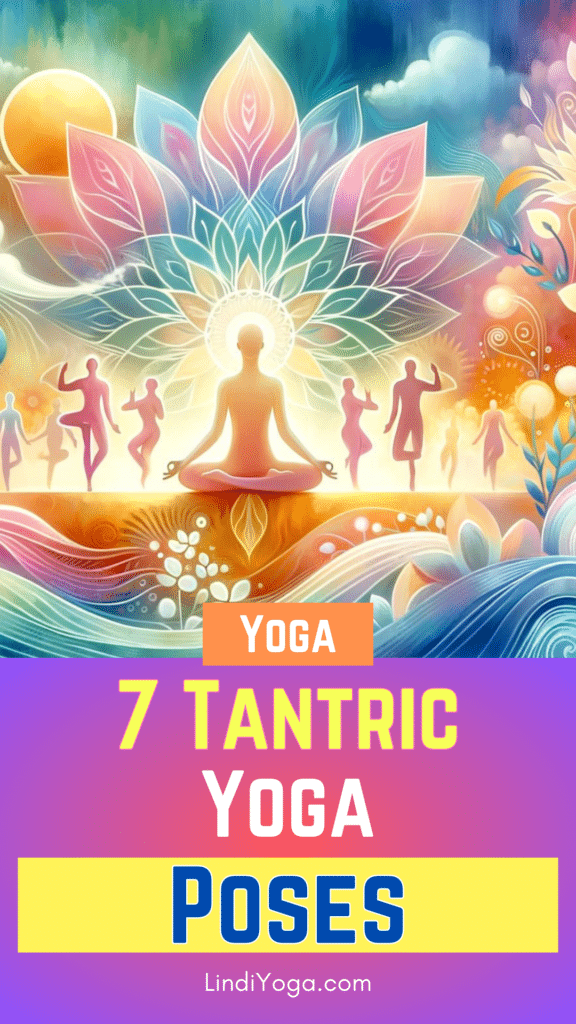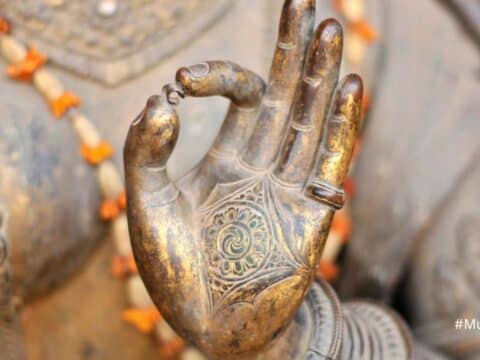Yoga Tantric poses to enhance your energy? When I hear the word Tantra, the first idea that comes to mind is a spiritual practice. This practice involves using sexual energy to achieve higher consciousness.
Most beginners would say that they want to improve their sex life or add more spice to it. They might also say they want better communication with their partner.
They might also express a desire to become more intimate. Some may also desire to learn more about various sexual positions. This can enhance their satisfaction.
Tantra is not what most people think it is. The question then becomes, what is it?
Podcast
What Tantra Means?
Tantra is an esoteric tradition with roots in Hindu and Buddhist philosophy. The collection of scriptures dates back to 300 and 400 CE.
These scriptures define spiritual technologies, techniques, and practices. It is rich in information about them.
People believe that the word Tantra consists of two Sanskrit words. These words are tanoti, which means expansion, and rayati, which means liberation.
One can see Tantra as a way to liberate energy and expand consciousness. It goes beyond the physical realm. Tantra is a technique that expands the mind and unlocks potential energy. Its principles underpin yogic practices.
We can define Tantra as a “web” or “network”. It refers to the interconnectedness of everything in our reality.
We can define Tantra with two primary and fundamental principles. Tantra, in short, has a very simplified definition.
- Tantra is the science and study of energy
- Tantra is a spiritual path that helps the soul evolve. It also aids in expanding consciousness.
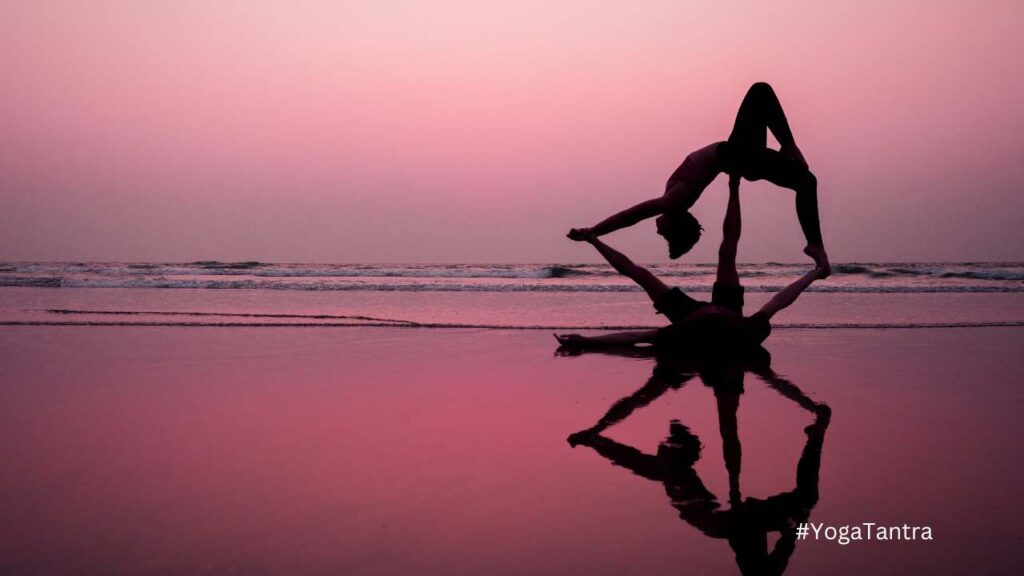
What Tantra is NOT
Tantra is not sex?
It’s important to know that Tantra is not sex. Tantra contains teachings on sex and sexuality. But, they are not the foundation of this system. In fact, the tantric sex teachings represent only 5%-10% of the tantric knowledge.
Tantra is not just about sexuality, there are many other areas that it covers.
Think of the world of Tantra as an old, strong tree with many branches. Tantric sex is just one of those branches, and it plays an important role in making the tree strong and complete.
Tantra is not a religion?
Tantra is not exclusive to any single religion. It’s a spiritual system open to everyone. All you need is the right attitude and commitment to follow it.
The tantric texts are written in a confusing manner. Those who have achieved advanced spiritual growth are the intended audience. They should be able to comprehend them.
The true tantric teachings were always kept secret. They were passed on by word of mouth from teacher to student. This happened after a long time of preparation, practice, and cleansing.
These valuable spiritual insights are more accessible now than before. People searching for them can find them easily.
There is no room for dogma or creed in the tantric tradition. Tantra is a “self-science”, a practical study of the self.
The master transmits teachings and techniques to the practitioner. Ultimately, it is up to the individual to practice and realize benefits.
Where Does Tantra Come From?
There is a great debate about the origins, history, and practice of Yoga Tantric. Some people believe that it is a body of knowledge that is complex and at times controversial.
The text suggests that the spiritual system of India is ancient, dating back 3,000 to 5,000 years ago. This system offers answers and explanations about energy and deities. It also covers the topics of the universe, reality, yoga, philosophy, and metaphysics.
How Tantra came westward
Against this backdrop, Westerners became increasingly interested in the teachings of Tantra. Tantra is thought to have first entered the Western world in the 1800s.
Scholars were introduced to its key concepts at that time. The hippie movement in the 1960s and 1970s revived spirituality.
It also brought about a sexual liberation. This sparked more interest in Tantra among Westerners.
The sexual teachings of Tantra were very appealing to this generation. As a result, the spiritual side of Tantra was not well known. This continues to be a problem, with few people being able to learn about the whole thing, not just the sexual part.
Tantra the Science and Study of Energy
Tantric masters understood that everything in this reality is made up of energy.
What is energy?
The Yoga Tantrics were fascinated by energy. Energy can rapidly advance one’s spiritual path.
There are numerous types of energy in our reality and universe that follow specific laws. If these laws are understood, it provides a way to control and master all energy.
An example of this would be electricity. It is a form of energy that, through scientific inquiry, human beings were able to understand the laws of. Electricity can now be created on command and at will. It is no longer just an ethereal concept.
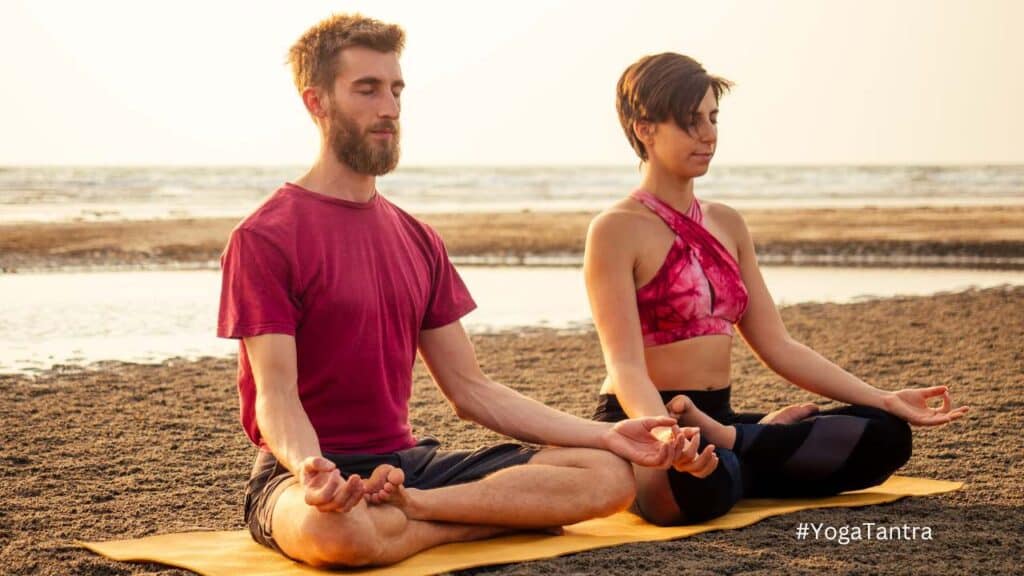
7 Yoga Tantric Postures
There are seven yoga poses that are said to increase feelings of freedom and self-trust.
Corpse Pose (Savasana)
This pose is a one-way ticket to Relaxation Station.
Incorporate these simple steps into your practice:
- Sit up tall. Bring your arms out to your sides and draw your palms together.
- Draw in your belly. Breathe out, pushing your stomach outward with each breath.
- Breathe in. Draw your shoulder blades back and push them together.
- Breathe out. Open your shoulders, bringing them away from your ears and bringing your head back.
- Breathe in. Lower your chin toward your chest. Keep your head and neck aligned with your spine.
- Breathe out. Bring your forehead toward your knees. And breathe in and out several times, letting go of tension in your shoulders.
- Continue breathing until you feel the body relaxing.
- Stay in the pose for 5 to 10 minutes.
Half Boat Pose (Ardha Navasana)
This core workout can give you a confidence boost and make you feel better about yourself.
How to do the half boat pose:
- Sit in a comfortable position on the floor. Sit on a block or cushion if you need to support yourself.
- Lift both legs off the ground and rest them on a wall behind you. You can either hold the foot of the left leg up on the wall or just rest your foot against it.
- Extend your right leg straight out in front of you. Bend your knee slightly, keeping your weight centered over your right foot.
- Fold your left arm across your chest, placing it just under your collarbone.
- Hold for 30 seconds to one minute.
- To come out of the pose, release your arm and sit up. Move your left leg back onto the ground.
- This pose can be done with the opposite leg on the wall as well, though you will have to change the arm position.
- Repeat this pose on the left side, alternating between left and right sides each time.
Chair Pose (Utkatasana)
This pose will help to improve your breathing and increase the heat in your core.
To do chair pose, you’ll start lying flat on the ground. That’s right, the ground. If you’re comfortable doing this, then you can.
- Lie on your back on the ground and keep your knees bent and together.
- Bend your elbows and place them under your shoulders. This should feel comfortable for you.
- Now, raise your chest up towards the sky. Raise your chin slightly.
- Reach out with both hands and take hold of the floor. You should be able to reach down about a foot and a half.
- Next, lift your hips up so that your thighs are parallel to the floor. You should be able to lift your hips up so that your thighs are straight, with your butt almost touching the ground.
- Inhale and push your butt forward. Squeeze your quads, glutes, and abs. Make sure that your back and your shoulders are engaged.
- Slowly release your arms and return to the starting position.
Empty Lakebed Pose (Tadaka Mudra)
This pose is calming and can help you control your breathing.
How to do Empty Lakebed Pose:
- Sit upright on the floor. Cross your legs, placing one foot flat on the floor, and the other foot slightly lifted off of the ground.
- Bend both knees and place your weight on your heels.
- Bring your palms in front of your body and extend your arms out to your sides.
- Slowly bring your head and shoulders forward as you inhale.
- As you exhale, slowly lower your head down until you reach your forearms.
- Place your forehead against your hands.
- Take a deep breath, and slowly roll your head back up to standing.
- Repeat the pose 2 or 3 times.
Mountain Pose (Tadasana)
This posture is great for becoming aware of your body and alignment.
- In order to practice this pose correctly, you should begin by sitting in a chair with your legs crossed, and your feet resting flat on the ground.
- Once you’re comfortable, you can slowly stand up by pushing off the chair.
- Make sure you keep your feet and knees straight as you stand up.
- As you get used to standing up from the chair, you can then start to bend your knees and lower your body until your knees are just past your ankles.
- Don’t let your knees touch the ground. Instead, focus on bending your knees until you feel comfortable.
- Once you reach this position, you can then lift your arms in front of your body.
- Bring your palms together in the shape of a mountain.
- As you exhale, slowly bring your hands toward each other until they meet in the middle.
- Then, inhale, and gently raise your hands up toward your chest.
- As you inhale, your arms should be at a 45-degree angle.
- As you exhale, lower your arms back down to your sides.
- Finally, close your eyes and take several slow breaths.
Warrior I (Virabhadrasana I)
This pose builds confidence and opens the chest.
- Stand straight with your legs hip width apart and your feet parallel.
- Your hands should be in prayer position (hands are held behind the back and palms face down).
- Keep your spine straight and chest open.
- Raise your arms above your head, and bend forward from the hips until you are in a straight line with your knees.
- Lower your head and torso down to a sitting position.
- Continue to keep your chin parallel to the floor.
- Draw the tailbone towards the pubic bone and lift the tailbone to avoid strain on the back.
- Look at the ceiling and keep your eyes focused on a spot.
- Breathe slowly and deeply.
- Hold this position for several minutes or until you feel calm and relaxed.
Wide-Legged Standing Forward Bend (Prasarita Padottanasana)
This stretch will help to relieve tension in your hips and calm your mind.
How to do a wide-legged standing forward bend
- Stand up straight and bend your knees so that you are in a lunge position.
- Take your left hand by your left hip, and place it on your left leg. Then, place your right hand in front of you, just above your right foot.
- Now, place your feet apart, and bring your arms together and wrap them around your chest.
- Keep your elbows close to your sides and your shoulders back. You should now look like this:
- Once you have reached this position, slowly lean forward.
- As you go forward, you should keep your body parallel to the ground, and your feet should remain in their original positions.
- Your legs should remain wide apart, and you should be careful not to fall forward.
If you cannot reach your hands to the floor when doing this exercise, try using a prop.
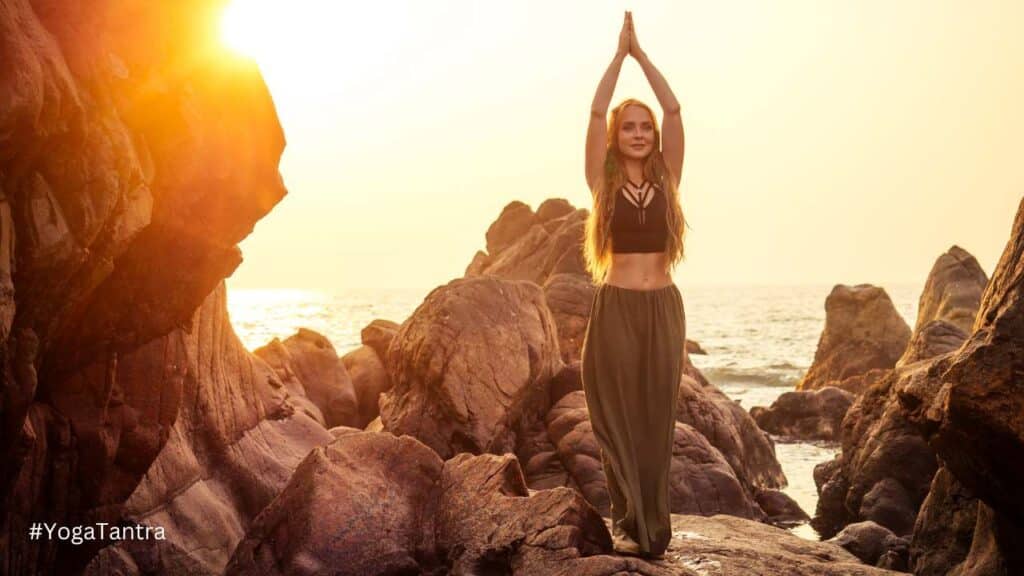
Solo vs. Partnered Tantric Yoga
What this boils down to is a matter of personal preference. You can either share a tantric experience with a lover, friend, or anyone you trust, or you can do it by yourself.
You should keep in mind that it may be difficult to practice tantra by yourself if you are new to it. Some experts suggest waiting to learn the basic principles first. After that, you can practice alone.
Home Practice
You can totally practice tantric yoga from the comfort of your own home. There are lots of great online classes you can sign up for. You can also look into local studios that offer virtual sessions.
After you understand how it works, you can make your own yoga sequence that follows the tantric tradition.
Some individuals choose to learn tantra from a guru privately. You can ask around your local yoga studio to find a certified and well-trusted instructor.
Studio Practice
If you want to try yoga tantric, be sure to go to a reputable studio. It can be an awesome experience to share with fellow yogis.
Here are some things to double-check before you sign up:
- It should be white tantra (aka not sexual).
- The class should involve chanting and meditation.
- The goal of the class should be related to self-growth.
- Classic tantra yoga classes should be solo, not partnered.
- The teacher should be certified in tantra, Hatha yoga, or Kundalini yoga.
Prepare Your Mind
It is just as important to prepare your mind for spiritual practice as it is to prepare your space. When your mind is chaotic or turbulent, your results will be similar. If you try to do practices or techniques, your mind must not be chaotic or turbulent.
That’s why you should prepare for yoga class. Learn about its mental and physical benefits.
Before you can begin your practice, it’s important to make sure that you’re ready. There’s nothing quite like the feeling of starting a new practice.
You’re excited to see what happens, but you’re also nervous about what it’s going to be like. You want to be sure that you’re comfortable with the process.
You can start your journey to a balanced lifestyle by preparing your body and mind for yoga.
1. Be Prepared to let go of expectations
When you first begin yoga tantric, it’s important to be prepared to let go of expectations. Some people expect to feel stronger after a yoga tantric session.
Others expect to bend and twist like a contortionist. If you have unrealistic expectations, you’re going to be disappointed.
Instead, concentrate on your practice and how you will navigate it. Avoid fixating on your emotions or accomplishments. You should leave your ego at the door.
2. Be realistic about your body type
If you’re new to yoga tantric classes, you might worry about finding the right position for you. If you are petite, consider choosing a practice that focuses on a lot of standing poses.
If you’re tall, you’ll likely be able to find a practice that uses more poses that are more forward-leaning.
There are many poses that are designed for each individual. If you have a particular physical issue, you can modify poses. This will assist in working on specific muscles.
3. Be prepared to do things that are new to you
Now you are ready to start your Yoga Tantric experience.
